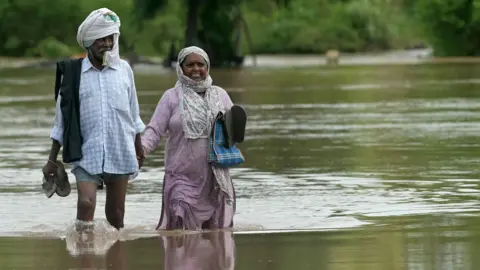Heavy monsoon rains in Punjab, Pakistan's most populated province, have wreaked havoc, leading to the deaths of at least 57 individuals, among them 24 children, due to the relentless downpour that began on Wednesday. The heavy rains caused widespread flooding across several cities and rural areas, with many fatalities resulting from collapsed buildings, according to the National Disaster Management Authority.
As the monsoon season commenced in late June, the country faced extreme weather patterns, marked by intense heat waves followed by torrential rain, killing at least 180 people and injuring hundreds more throughout this season. Chakwal, located around 60 miles south of Islamabad, has been severely affected, with local farmers like Malak Jamil expressing despair over loss of homes and crops, estimating their damage at over $6,000.
In response to the disaster, the Pakistani military has deployed helicopters to rescue over a hundred individuals trapped by the floods. Authorities continue to issue evacuation orders for those in low-lying areas as water levels continue to rise and infrastructure remains under threat. A brief respite from the heavy rains is forecasted, according to the Pakistan Meteorological Department.
Unfortunately, among the casualties, some individuals have lost their lives to electrocution. UNICEF issued a warning, underscoring the perilous situation for children, who face increased risks of drowning and waterborne diseases as floodwaters remain high.
Experts have indicated that climate change plays a significant role in intensifying the severity and frequency of these floods. Research shows that human activities are contributing to enhanced rainfall patterns, especially during the monsoon season, which typically lasts from July to September. The devastating floods of 2022 left over 1,700 people dead and millions displaced, with recovery efforts still ongoing.
With the growing challenges posed by climate-related disasters, disaster management officials emphasize the urgency in addressing the consequences of accelerated glacier melting in northern Pakistan, which further compounds the region's flooding risks.
As the monsoon season commenced in late June, the country faced extreme weather patterns, marked by intense heat waves followed by torrential rain, killing at least 180 people and injuring hundreds more throughout this season. Chakwal, located around 60 miles south of Islamabad, has been severely affected, with local farmers like Malak Jamil expressing despair over loss of homes and crops, estimating their damage at over $6,000.
In response to the disaster, the Pakistani military has deployed helicopters to rescue over a hundred individuals trapped by the floods. Authorities continue to issue evacuation orders for those in low-lying areas as water levels continue to rise and infrastructure remains under threat. A brief respite from the heavy rains is forecasted, according to the Pakistan Meteorological Department.
Unfortunately, among the casualties, some individuals have lost their lives to electrocution. UNICEF issued a warning, underscoring the perilous situation for children, who face increased risks of drowning and waterborne diseases as floodwaters remain high.
Experts have indicated that climate change plays a significant role in intensifying the severity and frequency of these floods. Research shows that human activities are contributing to enhanced rainfall patterns, especially during the monsoon season, which typically lasts from July to September. The devastating floods of 2022 left over 1,700 people dead and millions displaced, with recovery efforts still ongoing.
With the growing challenges posed by climate-related disasters, disaster management officials emphasize the urgency in addressing the consequences of accelerated glacier melting in northern Pakistan, which further compounds the region's flooding risks.


















